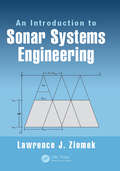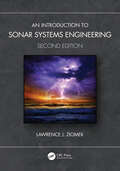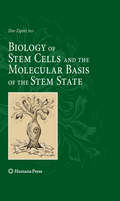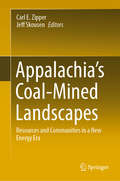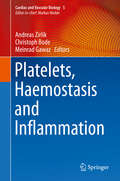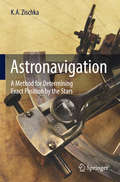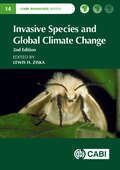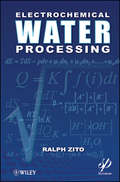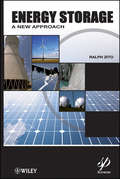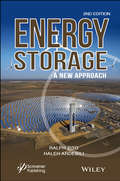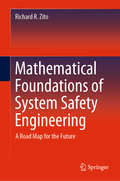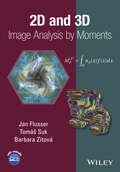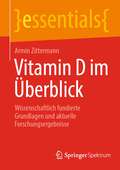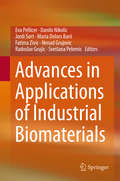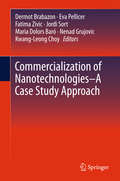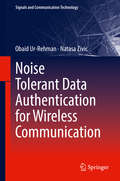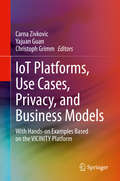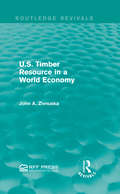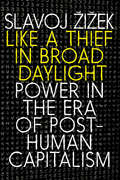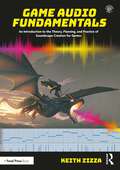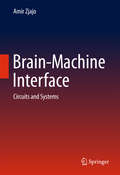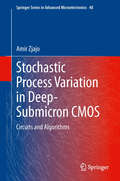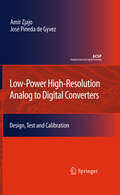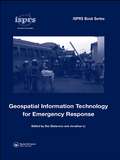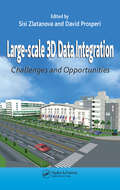- Table View
- List View
An Introduction to Sonar Systems Engineering
by Lawrence J. ZiomekWritten in tutorial style, this textbook discusses the fundamental topics of modern day Sonar Systems Engineering for the analysis and design of both active and passive sonar systems. Included are basic signal design for active sonar systems and understanding underwater acoustic communication signals. Mathematical theory is provided, plus practical design and analysis equations for both passive and active sonar systems. Practical homework problems are included at the end of each chapter and a solutions manual and lecture slides for each chapter are available for adopting professors.
An Introduction to Sonar Systems Engineering
by Lawrence J. ZiomekAn Introduction to Sonar Systems Engineering Second Edition Important topics that are fundamental to the understanding of modern-day sonar systems engineering are featured. Linear, planar, and volume array theory, including near-field and far-field beam patterns, beam steering, and array focusing, are covered. Real-world arrays such as the twin-line planar array and a linear array of triplets, which are solutions to the port/starboard (left/right) ambiguity problem associated with linear towed arrays, are examined in detail. Detailed explanations of the fundamentals of side-looking (side-scan) and synthetic-aperture sonars are presented. Bistatic scattering with moving platforms is explored with derivations of exact solutions for the time delay, time-compression/time-expansion factor, and Doppler shift at a receiver for both the scattered and direct acoustic paths. Time-domain and frequency-domain descriptions, and the design of CW, LFM, and Doppler-invariant HFM pulses, are explained. Target detection in the presence of reverberation and noise is examined. Time-domain and frequency-domain descriptions of MFSK, MQAM, and OFDM underwater acoustic communication signals are also discussed. Although the book is mathematically rigorous, it is written in a tutorial style. Many useful, practical design and analysis equations for both passive and active sonar systems are derived from first principles. No major steps in the derivation of important results are skipped – all assumptions and approximations are clearly stated. Particular attention is paid to the correct units for functions and parameters. Many figures, tables, examples, and practical homework problems at the end of each chapter are included to aid in the understanding of the material covered. New to the Second Edition Chapter 15 Synthetic-Aperture Sonar Chapter 13, Section 13.3, The Rectangular-Envelope HFM Pulse Chapter 10, Section 10.7, Moving Platforms, was rewritten, which allowed for the elimination of Appendix 10C from the first edition New explanations/discussions were added to Subsections 1.2.1 and 1.3.1 in Chapter 1 Appendix 1A was rewritten and the new Table 1A-1 was added to Chapter 1 A solutions manual is available for adopting professors
Biology of Stem Cells and the Molecular Basis of the Stem State (Stem Cell Biology and Regenerative Medicine)
by Dov ZiporiBiology of Stem Cells and the Molecular Basis of the Stem State concentrates upon adult stem cells, particularly on mesenchymal cell populations, which is the author's area of expertise. The text offers the reader a detailed description of the emergence of stem cell research and the dogmas that were created during the first decades of analysis of stem cell properties, particularly those of hemopoietic stem cells. Biology of Stem Cells and the Molecular Basis of the Stem State also introduces the reader to the commonly accepted notions regarding stem cell biology, with an emphasis on an alternative view of stemness, i.e. the stem state. In keeping with the popularity of this topic, Biology of Stem Cells and the Molecular Basis of the Stem State addresses the major controversies and points of dispute, among researchers in the stem cell field. Overall, Biology of Stem Cells and the Molecular Basis of the Stem State presents a well-rounded dialogue about stem cells as it not only concentrates upon the biological elements of stem cell, but also addresses the controversy and hype currently enveloping this popular subject.
Appalachia's Coal-Mined Landscapes: Resources and Communities in a New Energy Era
by Carl E. Zipper Jeff SkousenThis book collects and summarizes current scientific knowledge concerning coal-mined landscapes of the Appalachian region in eastern United States. Containing contributions from authors across disciplines, the book addresses topics relevant to the region’s coal-mining history and its future; its human communities; and the soils, waters, plants, wildlife, and human-use potentials of Appalachia’s coal-mined landscapes.The book provides a comprehensive overview of coal mining’s legacy in Appalachia, USA. It book describes the resources of the Appalachian coalfield, its lands and waters, and its human communities – as they have been left in the aftermath of intensive mining, drawing upon peer-reviewed science and other regional data to provide clear and objective descriptions. By understanding the Appalachian experience, officials and planners in other resource extraction- affected world regions can gain knowledge and perspectives that will aid their own efforts to plan and manage for environmental quality and for human welfare.Appalachia's Coal-Mined Landscapes: Resources and Communities in a New Energy Era will be of use to natural resource managers and scientists within Appalachia and in other world regions experiencing widespread mining, researchers with interest in the region’s disturbance legacy, and economic and community planners concerned with Appalachia’s future.
Platelets, Haemostasis and Inflammation (Cardiac and Vascular Biology #5)
by Andreas Zirlik Christoph Bode Meinrad GawazThe book depicts the various roles of platelets in a variety of cardio-metabolic diseases. Traditional and non-traditional platelet functions are described in detail in atherosclerosis, metabolic syndrome, diabetes, myocardial infarction, and other vascular pathologies. Particular focus is put on platelets as a link between haemostasis and inflammation contributing to both. Last but not least the books links the most recent advances in basic sciences with promising novel therapeutic applications and first results of clinical trials. The book is written for biomedical scientists in the sub disciplines vascular biology, biochemistry and immunology; and it as well will be of interest and value for academic physicians like cardiologists, hematologists, general internists and vascular surgeons.
Astronavigation: A Method for Determining Exact Position by the Stars
by K. A. ZischkaThis book acts as a manual for the ancient methods of navigating by the stars, which continue to provide the sailor or pilot with a timeless means of determining location. Despite the prevalence of GPS, a comprehensive set of formulae that can be evaluated on any inexpensive scientific calculator in the event of a catastrophic software or systems failure is a vital failsafe. It also serves as a living link to centuries of explorers from centuries past. Beginning with the basics of positional astronomy, this guide moves on to the more complex math necessary to understand the ephemerides, tables showing the future positions of the stars and planets. These astronomical almanacs were the satellite navigation of their day. The objective of this book is twofold: to provide the reader with a concise, comprehensible manual on positional astronomy as it applies to astro-navigation and to furnish the concise algorithms for finding the position of the Sun and various navigational stars at any given instant. In a world where too many mariners and aeronauts rely solely on technology and are vulnerable to solar flares, electrical issues, and the like, this knowledge can be a life-saving backup, not to mention a fascinating study in its own rights. Included is an exact mathematical way to determine your position in the air or on the sea far more quickly and accurately than by using the old celestial navigational method, without even needing to know or understand the underlying mathematics. There is even a section that teaches how to measure the azimuth of a star using an analog wrist watch so if a sextant gets damaged, locating position is still possible. This book offers mathematicians and adventurers a way to determine position when the skies go dark. The U. S. Navy has recently realized that their electronic navigation systems are vulnerable to cyberattack, and as a result has instructed the Naval Academy to begin teaching celestial navigation again.
Invasive Species and Global Climate Change (CABI Invasives Series)
by Lewis H. ZiskaThis book addresses topics related to the impact of invasive species including biosecurity, demographics, species diversity and food security. It is meant for researchers, upper-level students, and policy makers and provides a factual basis for the underlying science and a discussion of that information with respect to current and future impacts and possible solutions. This book explores the nexus of climate change and biological invasions, resulting impacts (biological and economic) and assesses ways to reduce vulnerability and increase the resiliency and sustainability of managed and unmanaged ecosystems. The book has three parts, focusing on: (1) the dimensions of the problem; background and science; (2) case studies; (3) Management: detection, prevention, control and adaptation. This revised edition examines a wide range of topics and region, the underlying science, examples (case studies) from around the world, and ways and means to recognize, manage and control the consequences. It includes new cases and new threats; for example, a chapter summarizing case studies regarding climate change and invasive species that are also disease carriers (e.g. ticks and Lyme disease). - Covers a wide range of topics and areas - Examines the synergy between invasive species and climate change - Explains options to control and mitigate effects This book is of interest to academics, researchers and students studying climate change and invasive species. Those interested in the environment and ecology, land managers, policy makers, agronomists, federal and state departments of natural resources, climate change activists, public health professionals.
Electrochemical Water Processing: A Compendium Of Analyses And Laboratory Notes Based Upon R&d In Electrochemical Energy Systems Technology
by Ralph ZitoEven though most of the Earth’s surface is covered with water, most of it is not directly usable for human consumption or applications. As the population increases and our general style of living standards increase, the importance useable water is becoming acute. This book addresses this issue with approaches to treating water sources that require removal of unwanted or dissolved substances. In particular, it covers various methods for removing dissolved ionic materials. There are numerous methods for accomplishing this end, and the book reviews most of them in some depth.
Energy Storage: A New Approach (Wiley-Scrivener #26)
by Ralph ZitoEnergy Storage: A New Approach presents practical solutions to the problem of energy storage on a massive scale. This revolutionary book describes technologies that include basic chemical concepts that engineers have been practicing for years, but presents new material that could transform the energy industry. Regardless where power is generated from—oil, natural gas, coal, solar, wind, or any of the other emerging sources— energy storage is something that the industry MUST learn and practice. With the world energy demand increasing, mostly due to industrial growth in China and India, and with the West becoming increasingly more interested in fuel efficiency and “green” endeavors, energy storage is potentially a key technology in our energy future.
Mathematical Foundations of System Safety Engineering: A Road Map for the Future
by Richard R. ZitoThis graduate-level textbook elucidates low-risk and fail-safe systems in mathematical detail. It addresses, in particular, problems where mission-critical performance is paramount, such as in aircraft, missiles, nuclear reactors and weapons, submarines, and many other types of systems where “failure” can result in overwhelming loss of life and property. The book is divided into four parts: Fundamentals, Electronics, Software, and Dangerous Goods. The first part on Fundamentals addresses general concepts of system safety engineering that are applicable to any type of system. The second part, Electronics, addresses the detection and correction of electronic hazards. In particular, the Bent Pin Problem, Sneak Circuit Problem, and related electrical problems are discussed with mathematical precision. The third part on Software addresses predicting software failure rates as well as detecting and correcting deep software logical flaws (called defects). The fourth part on Dangerous Goods presents solutions to three typical industrial chemical problems faced by the system safety engineer during the design, storage, and disposal phases of a dangerous goods’ life cycle.
2D and 3D Image Analysis by Moments
by Barbara Zitova Jan Flusser Tomas SukPresents recent significant and rapid development in the field of 2D and 3D image analysis 2D and 3D Image Analysis by Moments, is a unique compendium of moment-based image analysis which includes traditional methods and also reflects the latest development of the field. The book presents a survey of 2D and 3D moment invariants with respect to similarity and affine spatial transformations and to image blurring and smoothing by various filters. The book comprehensively describes the mathematical background and theorems about the invariants but a large part is also devoted to practical usage of moments. Applications from various fields of computer vision, remote sensing, medical imaging, image retrieval, watermarking, and forensic analysis are demonstrated. Attention is also paid to efficient algorithms of moment computation. Key features: Presents a systematic overview of moment-based features used in 2D and 3D image analysis. Demonstrates invariant properties of moments with respect to various spatial and intensity transformations. Reviews and compares several orthogonal polynomials and respective moments. Describes efficient numerical algorithms for moment computation. It is a "classroom ready" textbook with a self-contained introduction to classifier design. The accompanying website contains around 300 lecture slides, Matlab codes, complete lists of the invariants, test images, and other supplementary material. 2D and 3D Image Analysis by Moments, is ideal for mathematicians, computer scientists, engineers, software developers, and Ph.D students involved in image analysis and recognition. Due to the addition of two introductory chapters on classifier design, the book may also serve as a self-contained textbook for graduate university courses on object recognition.
Vitamin D im Überblick: Wissenschaftlich fundierte Grundlagen und aktuelle Forschungsergebnisse (essentials)
by Armin ZittermannVitamin D kann in der Haut durch die UV-B-Strahlung der Sonne gebildet sowie über bestimmte Lebensmittel und Supplemente zugeführt werden. Die aktive Vitamin-D-Form ist ein Steroidhormon mit Wirkungen in einer Vielzahl von Geweben. Ein Vitamin-D-Mangel ist in Deutschland weit verbreitet. Es gibt eine Reihe von Risikogruppen, vor allem aufgrund unzureichender kutaner Synthese. Neben den klassischen Vitamin-D-Mangelerkrankungen Rachitis und Osteomalazie ist ein Vitamin- D-Mangel vermutlich auch ein Risikofaktor für verschiedene weit verbreitete chronische Erkrankungen sowie für eine verkürzte Lebenserwartung. Zur Verbesserung der Vitamin-D-Versorgung der Bevölkerung sind umfangreichere Anreicherungsmaßnahmen von Lebensmitteln sowie eine stärkere Verwendung von Supplementen zu fordern.
Advances in Applications of Industrial Biomaterials
by Fatima Zivic Eva Pellicer Danilo Nikolic Jordi Sort Maria Baró Nenad Grujovic Radoslav Grujic Svetlana PelemisThis book presents recent advances in the development of biomaterials for industrial applications, and discusses the potential for substituting environmentally hazardous substances with environmentally friendly and degradable components. Focusing on both the material development and production technologies, it reviews different materials, as well as new production technologies and application areas. It also highlights the importance of incorporating organic materials into different composites to enable consumption of otherwise waste materials. Further it addresses biopolymers for the food industry, e. g. edible films and coatings in food production and biodegradable materials; the automotive industry; bio fuels, such as biodiesel based on organic constituents; and green composites in marine applications. Environmental protection aspects related to the protection of cultural heritage, and new nanoparticles, such as nano zerovalent iron, are also reviewed. Aimed at young researchers, professionals, chemical engineers and marine engineers, the book is the result of the joint efforts of different academic and research institutions participating in the WIMB Tempus project, 543898-TEMPUS-1-2013-1-ES-TEMPUS-JPHES, "Development of Sustainable Interrelations between Education, Research and Innovation at WBC Universities in Nanotechnologies and Advanced Materials where Innovation Means Business", co-funded by the European Union Tempus Program.
Commercialization of Nanotechnologies–A Case Study Approach: A Case Study Approach
by Fatima Zivic Eva Pellicer Jordi Sort Nenad Grujovic Dermot Brabazon Maria Dolors Baró Kwang-Leong ChoyThis book covers diverse areas in which nanoscience and nanotechnology have led to significant technological advances and practical applications, with special emphasis on novel types of nanomaterials and their applicability into a new generation of nano- and micro-devices. Different nanomaterials are reviewed with a focus on several practical application areas and their commercial utilization. Production technologies of nanomaterials are presented as one of the challenges today. Sectors where nanotechnology has already significantly contributed are presented, along with specific nanotechnology solutions: energy related sectors, NEMS/MEMS, micro power generators, spintronics and healthcare. The basic properties and applications of nanostructured thermoelectric materials, ferroelectric and piezoelectric nanomaterials are reviewed. Examples of several developed thin-film thermogenerators are shown. A review of existing solutions and developing challenges are given regarding sustainable energy production, photovoltaics, solar cells, hydrogen economy and improved classes of batteries as contributions to green products and circular economy. Novel, highly promising areas in nanotechnology, are shown, such as voltage-driven nano-spintronics. Recent advances in friction characterisation at the nano level are described. Several proven nanomaterials have been reviewed pertaining to biomedicine. The use of nanomaterials in ophthalmology and cosmetic industry are reviewed, and the potential for silver nanoparticles and iron-based nanomaterials in biomedicine, also with recognised challenges and possible threats of non-controlled use of nanomaterials. This work is the result of joint efforts of different companies, academic, and research institutions participating in WIMB Tempus project, 543898-TEMPUS-1-2013-1-ES-TEMPUS-JPHES, "Development of Sustainable Interrelations between Education, Research and Innovation at WBC Universities in Nanotechnologies and Advanced Materials where Innovation Means Business", co-funded by the Tempus Programme of the European Union.
Noise Tolerant Data Authentication for Wireless Communication (Signals And Communication Technology)
by Natasa Zivic Obaid Ur-RehmanThis book provides insight into the challenges in providing data authentication over wireless communication channels. The authors posit that established standard authentication mechanisms – for wired devices – are not sufficient to authenticate data, such as voice, images, and video over wireless channels. The authors propose new mechanisms based on the so-called soft authentication algorithms, which tolerate some legitimate modifications in the data that they protect. The authors explain that the goal of these algorithms is that they are tolerant to changes in the content but are still able to identify the forgeries. The authors go on to describe how an additional advantage of the soft authentication algorithms is the ability to identify the locations of the modifications and correct them if possible. The authors show how to achieve this by protecting the data features with the help of error correcting codes. The correction methods are typically based on watermarking, as the authors discuss in the book.Provides a discussion of data (particularly image) authentication methods in the presence of noise experienced in wireless communication;Presents a new class of soft authentication methods, instead of the standard hard authentication methods, used to tolerate minor changes in image data;Features authentication methods based on the usage of authentication tags as well as digital watermarks.
IoT Platforms, Use Cases, Privacy, and Business Models: With Hands-on Examples Based on the VICINITY Platform
by Carna Zivkovic Yajuan Guan Christoph GrimmThis book provides a comprehensive and consistent introduction to the Internet of Things. Hot topics, including the European privacy legislation GDPR, and homomorphic encryption are explained. For each topic, the reader gets a theoretical introduction and an overview, backed by programming examples. For demonstration, the authors use the IoT platform VICINITY, which is open-source, free, and offers leading standards for privacy. Presents readers with a coherent single-source introduction into the IoT;Introduces selected, hot-topics of IoT, including GDPR (European legislation on data protection), and homomorphic encryption;Provides coding examples for most topics that allow the reader to kick-start his own IoT applications, smart services, etc.
U.S. Timber Resource in a World Economy (Routledge Revivals)
by John A. ZivnuskaThis book, first published in 1967, presents a concise picture of the demand and supply trends of timber around the world. Zivnuska provides a keen analysis of plans, prospects, and opportunities in the areas covered, and an interesting look at the North American forest economy. This book will be of interest to students of environmental studies and forestry.
Like a Thief in Broad Daylight: Power in the Era of Post-Human Capitalism
by Slavoj ZizekThe latest book from "the most despicable philosopher in the West" (New Republic) considers the new dangers and radical possibilities set in motion by advances in Big Tech.In recent years, techno-scientific progress has started to utterly transform our world--changing it almost beyond recognition. In this extraordinary new book, renowned philosopher Slavoj Žižek turns to look at the brave new world of Big Tech, revealing how, with each new wave of innovation, we find ourselves moving closer and closer to a bizarrely literal realization of Marx's prediction that "all that is solid melts into air." With the automation of work, the virtualization of money, the dissipation of class communities, and the rise of immaterial, intellectual labor, the global capitalist edifice is beginning to crumble, more quickly than ever before--and it is now on the verge of vanishing entirely.But what will come next? Against a backdrop of constant socio-technological upheaval, how could any kind of authentic change take place? In such a context, Žižek argues, there can be no great social triumph--because lasting revolution has already come into the scene, like a thief in broad daylight, stealing into sight right before our very eyes. What we must do now is wake up and see it. Urgent as ever, Like a Thief in Broad Daylight illuminates the new dangers as well as the radical possibilities thrown up by today's technological and scientific advances, and their electrifying implications for us all.
Game Audio Fundamentals: An Introduction to the Theory, Planning, and Practice of Soundscape Creation for Games
by Keith ZizzaGame Audio Fundamentals takes the reader on a journey through game audio design: from analog and digital audio basics to the art and execution of sound effects, soundtracks, and voice production, as well as learning how to make sense of a truly effective soundscape. Presuming no pre-existing knowledge, this accessible guide is accompanied by online resources – including practical examples and incremental DAW exercises – and presents the theory and practice of game audio in detail, and in a format anyone can understand. This is essential reading for any aspiring game audio designer, as well as students and professionals from a range of backgrounds, including music, audio engineering, and game design.
Brain-Machine Interface: Circuits and Systems
by Amir ZjajoThis book provides a complete overview of significant design challenges in respect to circuit miniaturization and power reduction of the neural recording system, along with circuit topologies, architecture trends, and (post-silicon) circuit optimization algorithms. The introduced novel circuits for signal conditioning, quantization, and classification, as well as system configurations focus on optimized power-per-area performance, from the spatial resolution (i. e. number of channels), feasible wireless data bandwidth and information quality to the delivered power of implantable system.
Stochastic Process Variation in Deep-Submicron CMOS
by Amir ZjajoOne of the most notable features of nanometer scale CMOS technology is the increasing magnitude of variability of the key device parameters affecting performance of integrated circuits. The growth of variability can be attributed to multiple factors, including the difficulty of manufacturing control, the emergence of new systematic variation-generating mechanisms, and most importantly, the increase in atomic-scale randomness, where device operation must be described as a stochastic process. In addition to wide-sense stationary stochastic device variability and temperature variation, existence of non-stationary stochastic electrical noise associated with fundamental processes in integrated-circuit devices represents an elementary limit on the performance of electronic circuits. In an attempt to address these issues, Stochastic Process Variation in Deep-Submicron CMOS: Circuits and Algorithms offers unique combination of mathematical treatment of random process variation, electrical noise and temperature and necessary circuit realizations for on-chip monitoring and performance calibration. The associated problems are addressed at various abstraction levels, i. e. circuit level, architecture level and system level. It therefore provides a broad view on the various solutions that have to be used and their possible combination in very effective complementary techniques for both analog/mixed-signal and digital circuits. The feasibility of the described algorithms and built-in circuitry has been verified by measurements from the silicon prototypes fabricated in standard 90 nm and 65 nm CMOS technology.
Low-Power High-Resolution Analog to Digital Converters
by Amir Zjajo José Pineda de GyvezWith the fast advancement of CMOS fabrication technology, more and more signal-processing functions are implemented in the digital domain for a lower cost, lower power consumption, higher yield, and higher re-configurability. This has recently generated a great demand for low-power, low-voltage A/D converters that can be realized in a mainstream deep-submicron CMOS technology. However, the discrepancies between lithography wavelengths and circuit feature sizes are increasing. Lower power supply voltages significantly reduce noise margins and increase variations in process, device and design parameters. Consequently, it is steadily more difficult to control the fabrication process precisely enough to maintain uniformity. The inherent randomness of materials used in fabrication at nanoscopic scales means that performance will be increasingly variable, not only from die-to-die but also within each individual die. Parametric variability will be compounded by degradation in nanoscale integrated circuits resulting in instability of parameters over time, eventually leading to the development of faults. Process variation cannot be solved by improving manufacturing tolerances; variability must be reduced by new device technology or managed by design in order for scaling to continue. Similarly, within-die performance variation also imposes new challenges for test methods. In an attempt to address these issues, Low-Power High-Resolution Analog-to-Digital Converters specifically focus on: i) improving the power efficiency for the high-speed, and low spurious spectral A/D conversion performance by exploring the potential of low-voltage analog design and calibration techniques, respectively, and ii) development of circuit techniques and algorithms to enhance testing and debugging potential to detect errors dynamically, to isolate and confine faults, and to recover errors continuously. The feasibility of the described methods has been verified by measurements from the silicon prototypes fabricated in standard 180nm, 90nm and 65nm CMOS technology.
Geospatial Information Technology for Emergency Response
by Sisi Zlatanova Jonathan LiDisaster management is generally understood to consist of four phases: mitigation, preparedness, response and recovery. While these phases are all important and interrelated, response and recovery are often considered to be the most critical in terms of saving lives. Response is the acute phase occurring after the event, and includes all arrangemen
Large-scale 3D Data Integration: Challenges and Opportunities
by Sisi Zlatanova David ProsperiLarge-Scale 3D Data Integration: Challenges and Opportunities examines the fundamental aspects of 3D geo-information, focusing on the latest developments in 3D GIS (geographic information) and AEC (architecture, engineering, construction) systems. This book addresses policy makers, designers and engineers, and individuals that need to overco
